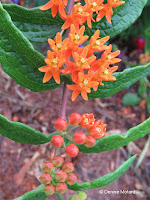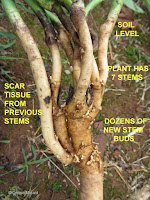BUTTERFLY MILKWEED
The Butterfly milkweed latin name is called ‘Tuberosa’ due to its long fibrous tap root (which makes it difficult to transplant). It prefers drier soils than the Swamp Milkweed. It is shorter than the latter, about up to one meter (3 ft) high.
The orange (sometimes yellow) clusters of flowers are rather flat on top of the stems, and the seed pods stand up vertically. The pods are hairy and purple, and longer than the pods from Swamp Milkweed. The leaves are alternate, narrow and pointed, and of a darker green shade than the Swamp Milkweed leaves.
Each season the tap root develops new stem buds for the following year, but these buds start underground near the surface. The seed pods mature about a month after those of the Swamp Milkweed.
A Butterfly Milkweed plant lives about 4-5 years in the wild, somewhat longer in a garden.
Butterfly Milkweed is VERY SLOW to start growing back in the spring (at least on Prince Edward Island), so it’s easy to be misled and believe it didn’t survive the winter. Then you plant something else in that spot, only to find your Butterfly Milkweed popping up again a few weeks later…..
COLLECTING THE SEEDS: Unless you want your milkweed to spread from seed all over the area around the plants and further, you need to deadhead the pods when they are forming.
Or, if you want to collect the seeds, the time for harvesting the pods is when they start to split open. Once the pods are fully open, it doesn’t take long before the wind quickly disperses all those beautiful little silky parachutes.
 |
| Butterfly milkweed spring shoots |
 |
| Butterfly milkweed shoots |
 |
| Butterfly milkweed in 2009, but in 2020... |
 |
| Badly located Butterfly milkweed |
 |
| Butterfly milkweed flowers with honey bees |
 |
| Butterfly milkweed may bloom yellow too |
 |
| Butterfly milkweed flowers close up |
 |
| Blooms sometimes have that shape |
 |
| Butterfly milkweed leaves are spirally arranged |
 |
| Butterfly milkweed leaves are glossy on top, hairy under |
 |
| Unripe Butterfly milkweed seedpods |
 |
| Butterfly milkweed seedpods are about 4 in. long |
 |
| Ripe Butterfly milkweed seedpods |
 |
| Butterfly milkweed seeds dispersing |
 |
| Butterfly milkweed seeds |
 |
| Butterfly milkweed has tap roots |
 |
| Butterfly milkweed roots closer view |
 |
| Older Butterfly milkweed tap root |